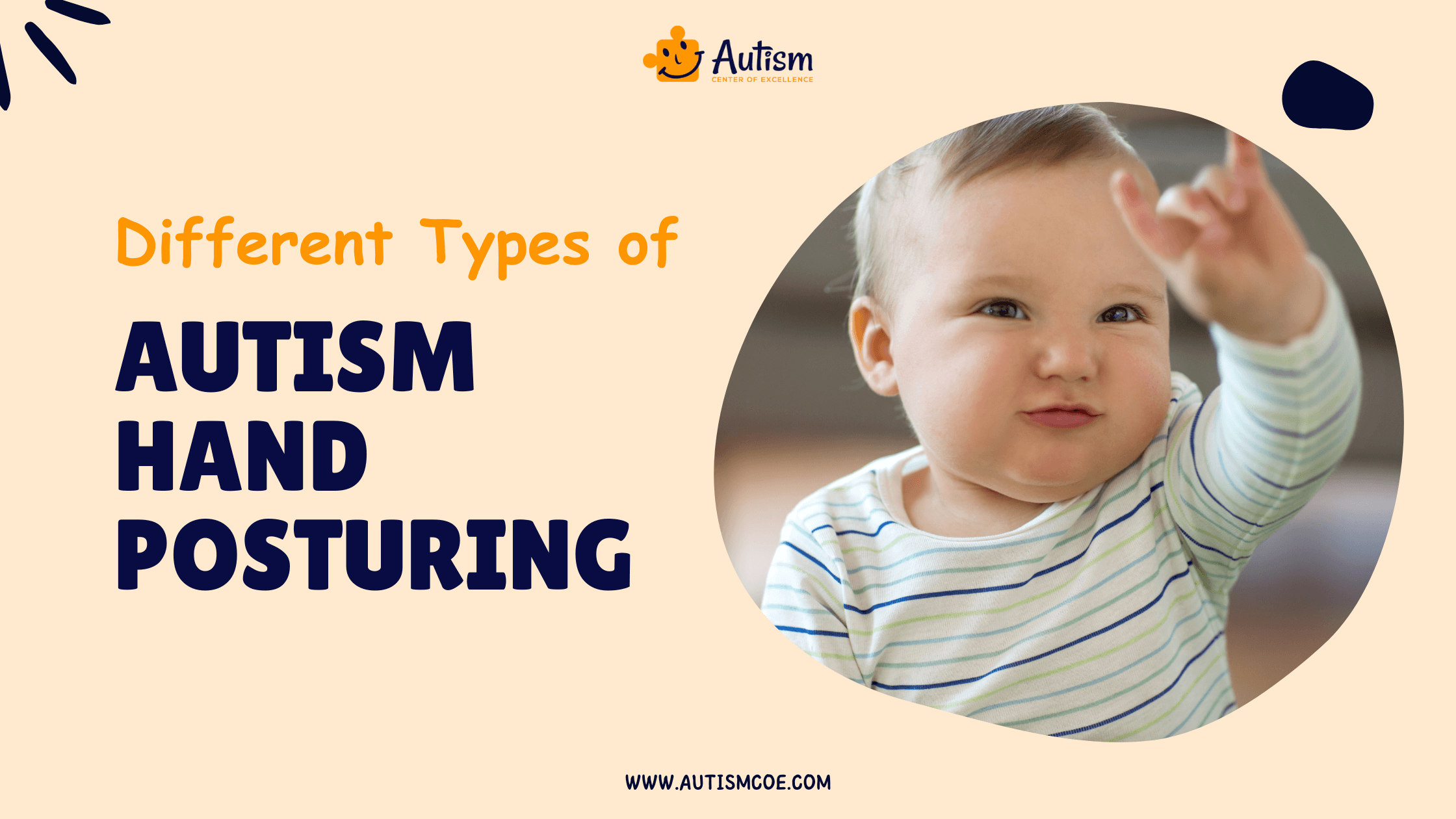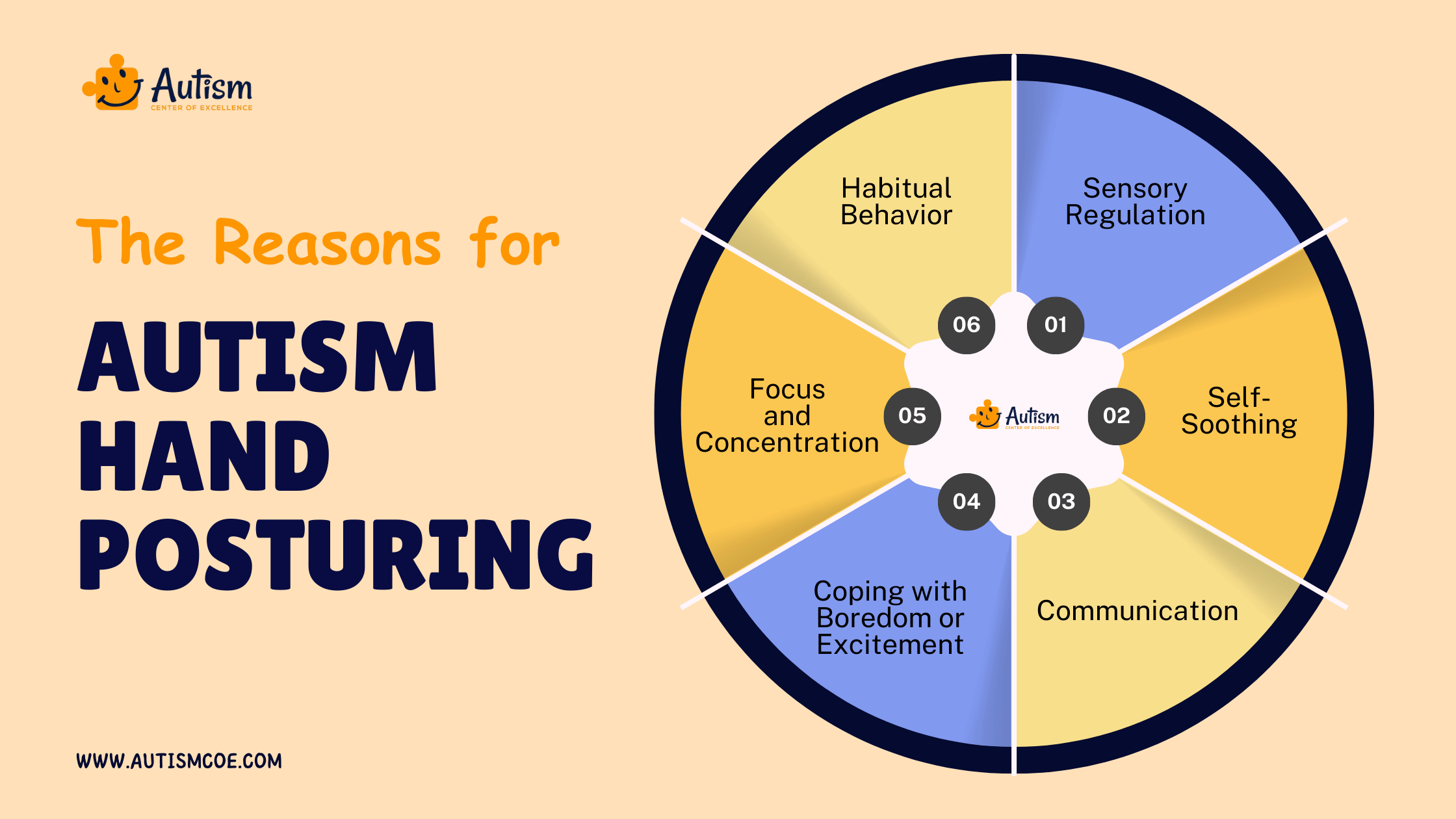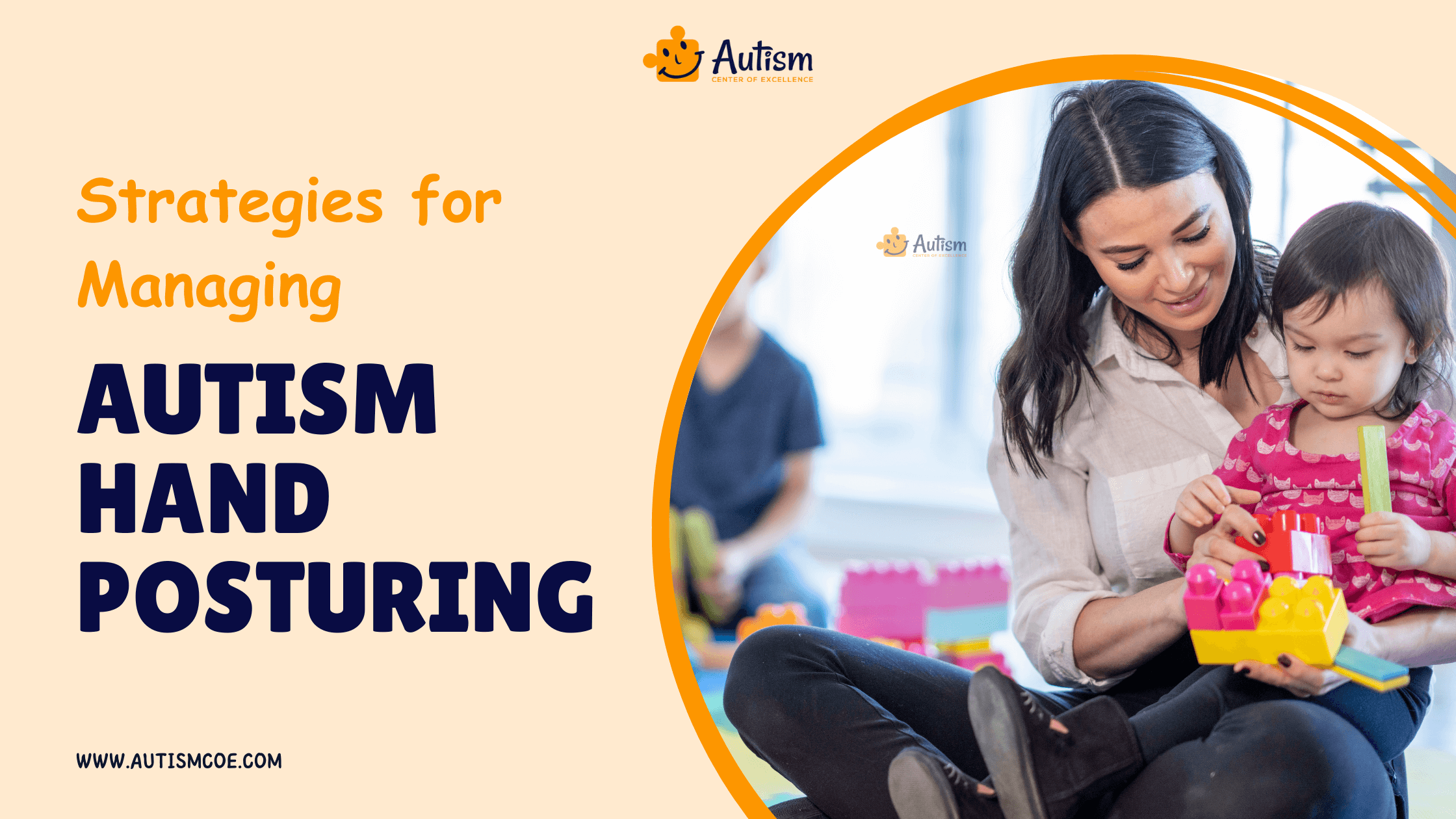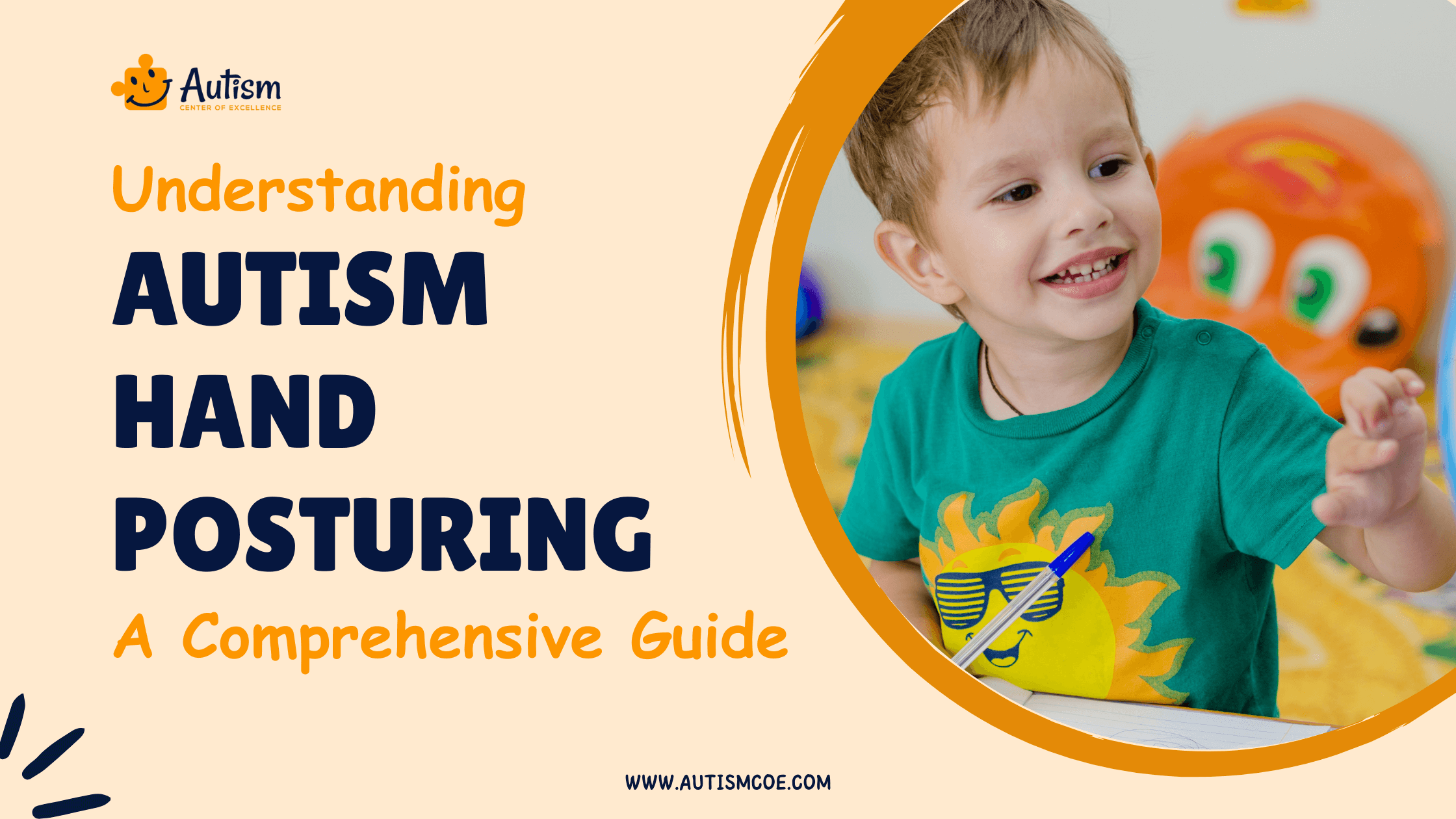Hand posturing, observed in children with Autism Spectrum Disorder (ASD), refers to repetitive hand movements like hand-flapping or finger tapping. These behaviors hold significance in understanding ASD, shedding light on sensory differences and communication challenges. Hand posturing serves various functions for children with Autism, from self-soothing to expressing emotions. However, excessive hand posturing can disrupt daily life. Understanding this behavior helps provide tailored support and interventions for children with Autism to thrive. This blog is designed to unravel the mystery of Autism hand posturing for those who care for children with Autism. Providing insight, understanding, and strategies to foster a supportive environment.
What is Autism Hand Posturing?
Autism hand posturing refers to a number of repetitive hand movements that autistic children may do. They are characterized by purposelessness, repeating in a rhythmic or stereotyped fashion. For instance, hand flap occurs when the hands or arms move rapidly in a repetitive manner, usually in an up-and-down motion. Finger flicking is an action of repeatedly flicking fingers onto each other or a surface and hand twisting is a motion of twisting or wringing hands in a rhythm.
Hand posturing behaviors occur in some children with Autism and tend to become habitual due to the fact that they make the children’s environment and lives predictable thereby providing them with a sense of security. Such behaviors also happen in response to specific cues or situations, like shifts or alteration in routine.
In general, understanding Autism hand posturing means realizing the complexity of the interaction of sensory, emotional, and communication aspects in children with autism. Understanding the reasons that lead to these behaviors helps to provide children with autism a suitable level of support that assists them in living a good quality of life.

Different Types of Autism Hand Posturing
Hand posturing is one of the common behaviors usually observed in children with Autism Spectrum Disorder (ASD). Let’s take a closer look at the different types of autistic hand posturing frequently noticed in children with ASD and learn about the nature of these repetitive and stereotypic hand movements.
1️⃣ Hand-Flapping:
- Hand-flapping means fast and repetitive movements of both hands or arms, usually up and down.
- This could include gestures such as waving one’s hand back and forth, fluttering the fingers, or repetitively clapping hands together.
2️⃣ Finger Flicking:
- Finger flicking is a practice that describes the process of flicking one’s fingers in rapid succession against another or any surface.
- The children may flick their fingers rapidly or tap them repeatedly on objects.
3️⃣ Hand Twisting:
- Hand twisting is a type of repetitive twisting or wringing of the hands.
- Children might twist their hands around one another or fidget with twisting motions using their fingers.
4️⃣ Finger Tapping:
- Finger tapping consists of tapping the fingers against a surface or themselves regularly.
- This gesture may include rhythmically tapping fingers or tapping them in a pattern.
5️⃣ Hand Rubbing:
- Hand rubbing is rubbing the palms against each other or surfaces.
- Children may rub their palms against each other in a round movement or on other objects for sensory stimulation.
6️⃣ Clapping or Patting
- Several children may continuously clap their hands or slap them on surfaces or parts of their bodies.
- This may depend on the magnitude and frequency of an individual’s feelings or situation.
7️⃣ Pressing Hands Together
- Pressing the hands together firmly, sometimes applying pressure to certain parts of the hand or fingers, is another form of autistic hand posturing.
- This can provide a sense of pressure that is calming for some children.
8️⃣ Complex Hand Movements
- This involves complex movements that consist of several steps or patterns, like interlocking fingers in certain patterns, spinning hands around each other, and holding shapes.
- Such movements are highly individualized and act as a sort of self-expression or even a coping mechanism.
Repetitive movements of the hands are known for their repetitive nature and the apparent lack of goal. The movements may become stereotyped, which indicates they follow a predictable sequence.
Children with Autism engage in these hand-posturing behaviors as a work of self-stimulation, also called skimming. Children can control their sensory stimulation by swimming to relieve anxiety, tension, or sadness and express feelings.
While hand posturing behaviors are common in children with autism, it’s essential to recognize that they serve different functions for each individual. Understanding the types of autism hand posture observed in children with ASD can provide valuable insights into their sensory, emotional, and communication needs, allowing for more tailored support and interventions.

The Reasons for Autism Hand Posturing
Hand posturing is a typical behavior in children with Autism Spectrum Disorder (ASD) that has a highly varied presentation and frequency. Understanding the reasons why children behave this way is vital for providing effective support and intervention to children with autism.
Sensory Regulation
Sensory regulation is one of the main causes of hand posturing and other stimming behaviors in Autism. Sensory processing differences are common among children with ASD, which is the reason they are either hypersensitive (over-responsive) or hyposensitive (under-responsive) to sensory input. Hand posturing is one of the strategies they use for self regulation of their sensory system, i.e. they generate less stimulation themselves by minimizing eye contact, talking softly, or flapping or twisting their hands. Although they avoid getting stimulating input, it is possible that by twisting or flapping their hands in front of their eyes, they stimulate themselves and . provides a way for them to manage overstimulation or seek additional stimulation.
Self-Soothing
Posturing of hands may serve as a self-soothing during stress, anxiety, or discomfort. The repetitive nature of such movements may be soothing which will help to reduce stress and improve emotional regulation.
Communication
For some children with Autism, particularly non-verbal or those with limited verbal communication skills, autism hand posturing is a form of non-verbal communication. Such gestures might reflect enthusiasm, anger, or other emotions in the absence of words.
Coping with Boredom or Excitement
Autism hand posturing may also manifest when the listener is bored or too excited. During low-stimulation periods, these movements may serve as a form of entertainment. On the other hand, with the emotions of intense happiness or excitement, autism hand posturing serves as a means to express and process such intensified emotions.
Focus and Concentration
Certain children discover that hand posturing is indeed an effective self-regulatory tool, and it enhances their concentration on activities. The rhythmic movements may either help maintain cognitive attention or provide an avenue for physical release of excessive energy, which will, improve task attention.
Habitual Behavior
With time, hand posture can turn into a habitual action. Once developed, such behaviors tend to provide a certain kind of comfort because of their known character despite the fact that the initial reason for the behavior has disappeared or become irrelevant.
The understanding of the complex nature of hand posturing in Autism involves analyzing the person’s sensory, emotional, and communication needs. Recognizing the potential causes and triggering factors of hand posturing behaviors will allow caregivers, educators, and therapists to devise strategies and interventions in supporting children with Autism in dealing with these behaviors properly.
Join Our Weekly Newsletters!
Subscribe now to stay updated with our latest email updates.
The Impact of Autism Hand Posturing
The hand posturing behaviors in children with Autism Spectrum Disorder (ASD) can have a great impact on activities of daily living and social interaction. Let’s discuss how these behaviors impact children with Autism and the challenges they present in everyday living.
Sensory Overload: One reason children use hand posturing as a form of sensory modulatory behavior is that they find certain environments, such as schools or public places, overwhelming, which in turn leads to an increase in hand posturing. It may impact their ability to engage in certain activities.
Real-life Scenario: A child with Autism may start hand flapping in a busy grocery store because the bright lights, loud noises, and sheer number of people are too much for them. It can be tough for a child to follow instructions, stay focused at the store, or keep calm during an outing.
Communication Barriers: Hand posturing can function as a non-verbal gesture for certain people, meanings of which can be confusing to others. This situation can result when both parties misunderstand each other or when one side is frustrated.
Real-life Scenario: The purpose of such hand movements is to communicate that a person wants to rest or is nervous. If caregivers or educators do not recognize these cues, the person’s needs may remain unresolved, creating more frustration and behavioral issues.
Perception and Stigma: Hand posturing may sometimes draw wrong attention or judgment if the person is unaware of the behaviors that are part of Autism. Negatively impacting a person’s self-esteem may make them shy away from social situations.
Real-life Scenario: A student makes a hand gesture during a school assembly because the event is carrying him away. Other students begin to whisper and stare, making the student with Autism feel embarrassed and excluded, leading to their inability to participate in such events.
Social Exclusion: Social exclusion may result from misunderstandings or ignorance of the fact that people with autism may exhibit unfamiliar hand postures, leading to peers avoiding them.
Real-life Scenario: During a birthday party, a child using some hand posturing for sensory regulation may be excluded from group fun or games as the kids do not understand what they are doing and thus keep their distance.
Hand posture in children with autism ultimately translates to a lifetime problem in their social interactions. The autism caregivers, educators, and community must know, as well as support, the children with autism in the management of such behaviors. Acceptance, interventions, and inclusive environments will help autistic children thrive despite the problems of hand posture.

Strategies for Managing Autism Hand Posturing
Management of hand posturing in children with Autism Spectrum Disorder (ASD) requires a combination of awareness, tolerance, and proactive interventions. Here are some practical tips and strategies for parents, caregivers, and educators to help manage autism hand posturing effectively:
Understand the Purpose Behind the Behavior
- Watch for the settings where hand posturing takes place to analyze its role (e.g., self-regulation, sensory seeking, expression of feelings).
- Admit that autism hand posturing is a type of communication or a method to deal with sensory issues.
Create a Sensory-Friendly Environment
- Minimize sensory overload in the environment by reducing loud noises, bright lights, and clutter.
- Provide a quiet and safe space where the individual can retreat if feeling overwhelmed.
Introduce Sensory Tools and Activities
- Offer sensory toys such as stress balls, fidget spinners, or textured objects that can provide an alternative source of sensory input.
- Include activities in daily routines that meet sensory needs, such as jumping on a trampoline for proprioceptive input or playing with water beads for tactile stimulation.
Teach Alternative Coping Skills
- Train the children on effective coping skills besides hand posturing, like deep breathing exercises, mindfulness techniques, and progressive muscle relaxation.
- Promote the application of verbal or visual indicators when the person is overstimulated or requires a pause.
Provide Positive Reinforcement
- Reinforce positive behaviors and efforts to self-regulate by praising and rewarding the individual when they use alternative coping strategies or engage in appropriate activities.
- Use a token system or visual rewards chart to motivate and encourage positive behavior.
Incorporating Occupational Therapy
- Occupational Therapy is essential in the treatment of autism hand posturing behaviors among children with autism and in assisting them to acquire functional skills and self-regulation strategies.
- The OT sessions might consist of sensory integration tasks and fine motor practices, along with interventions for treating sensory processing disorder and developing adaptive behaviors.
- Sensory integration activities can be practiced during daily routines at home, school, and therapy settings to allow children to explore, regulate, and engage in sensory activities.
Promote Self-Regulation Skills
- Teach what relaxation techniques, e.g., deep breathing or guided imagery, should be practiced as an alternative to hand posturing in handling stress or sensory overload.
- Include awake consciousness and mindfulness activities, such as yoga or tai chi.
Seek Professional Support
- Seek advice from healthcare professionals, therapists, or behavior specialists for personal adjustment and support in controlling autism hand posturing behaviors.
- Work with educators and therapists to create personalized behavior plans and interventions based on an individual’s unique needs and preferences.
By implementing these management strategies and providing supportive environments, caretakers, educators, and therapists can assist children with autism by reducing hand posturing and improving the quality of their lives. People are different; thus, it takes time, trial, and error to find the best strategies for every case of hand posturing.
Frequently Asked Questions & Answer
Is Hand Posturing in Autism Harmful?
The hand posturing of Autism is usually not harmful though it might highlight sensory needs or self-stimulation. Monitoring for injury or interruption of normal daily activity is vital.
Can Medication Assist in Managing Hand Posturing in Autism?
Medication is not usually prescribed specifically for hand posturing. However, it may be used to address co-occurring symptoms like anxiety or hyperactivity, which could indirectly affect hand posturing.
Can Occupational Therapy Aid in Managing Hand Posturing in Autism?
Yes, occupational therapy can helpful by enhancing fine motor skills, sensory processing, as well as, self-regulation, and may reduce hand posturing behaviors.
At What Age Does Hand Posturing Typically Begin in Autism?
Hand posturing can begin at different ages, from infancy to adolescence, according to individual development and sensory demands. Early management is also imperative in dealing with any issues related to hand posturing.
Conclusion
Hand posturing in Autism should be handled with empathy, proactive support, and understanding, and children who have Autism need to do well and be happy. Through understanding the special needs and behaviors of children with autism, we can develop inclusive environments that help the children to grow their strengths and overcome their weaknesses. It is important to realize that autism hand posturing behaviors are a type of communication and self-expression for children with autism. Rather than consider these behaviors disruptive or unacceptable, it is important to seek the reason for them and deliver appropriate support and interventions. We, as caregivers, educators, therapists, and members of society, have an important job of advocating for children with autism and of creating an environment of acceptance, inclusion, and support. Apart from these services, the Autism Center of Excellence provides support services that all children with autism require, giving resources, education, and support to families, educators, and professionals. AutismCOE offers ABA Therapy, Autism Early Intervention Program, Autism School Readiness Program, Speech Therapy, and Occupational Therapy services for children aged 2 – 14 in-home and center-based environments.
Please Note: The content of this blog is for informational purposes only and should not be considered a substitute for professional medical advice, diagnosis, or treatment. Consult a qualified healthcare professional for personalized guidance tailored to your specific situation.

Bhavika Bhasin
Bhavika Bhasin is the Research and Marketing officer at AutismCOE. She works with children and adults with ASD. Her clinical research includes evaluating various available autism screening and diagnosis methods and their efficacy. She is currently developing a novel screening exam that is indicated to be more accurate than the existing available exams. She is also writes articles papers for various publications.


